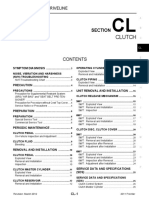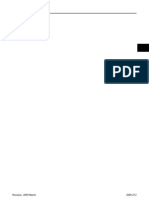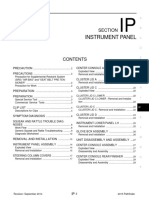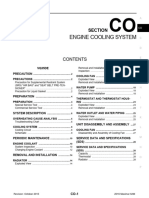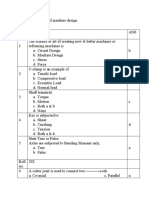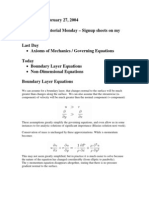Clutch: Section
Clutch: Section
Uploaded by
Tony RojasCopyright:
Available Formats
Clutch: Section
Clutch: Section
Uploaded by
Tony RojasOriginal Title
Copyright
Available Formats
Share this document
Did you find this document useful?
Is this content inappropriate?
Copyright:
Available Formats
Clutch: Section
Clutch: Section
Uploaded by
Tony RojasCopyright:
Available Formats
TRANSMISSION & DRIVELINE
SECTION CL CLUTCH
B
CL
E
CONTENTS
PRECAUTION ............................................... 2 Removal and Installation .........................................10 F
Inspection ................................................................10
PRECAUTIONS ................................................... 2
Precaution for Supplemental Restraint System CLUTCH MASTER CYLINDER ........................ 11
G
(SRS) "AIR BAG" and "SEAT BELT PRE-TEN- Exploded View .........................................................11
SIONER" ................................................................... 2 Removal and Installation .........................................11
Precautions Necessary for Steering Wheel Rota- Inspection and Adjustment ......................................13
H
tion After Battery Disconnection ................................ 2
General Precautions ................................................. 3
CLUTCH PIPING ............................................... 14
Exploded View .........................................................14
PREPARATION ............................................ 4 Hydraulic Layout ......................................................14 I
Removal and Installation .........................................14
PREPARATION ................................................... 4 Inspection and Adjustment ......................................15
Special Service Tools ................................................ 4
Commercial Service Tools ........................................ 4 UNIT REMOVAL AND INSTALLATION ...... 16 J
SYMPTOM DIAGNOSIS ............................... 5 CSC (CONCENTRIC SLAVE CYLINDER) ....... 16
Exploded View .........................................................16 K
NOISE, VIBRATION AND HARSHNESS Removal and Installation .........................................16
(NVH) TROUBLESHOOTING ............................. 5 Inspection and Adjustment ......................................16
NVH Troubleshooting Chart ...................................... 5
CLUTCH DISC AND CLUTCH COVER ............ 17 L
PERIODIC MAINTENANCE .......................... 6 Exploded View .........................................................17
Removal and Installation .........................................17
CLUTCH PEDAL ................................................. 6 Inspection ................................................................18 M
Inspection .................................................................. 6
SERVICE DATA AND SPECIFICATIONS
CLUTCH FLUID ................................................... 7 (SDS) ............................................................ 20
Inspection .................................................................. 7 N
Draining ..................................................................... 7 SERVICE DATA AND SPECIFICATIONS
Refilling ..................................................................... 8 (SDS) ................................................................. 20
Air Bleeding ............................................................... 9 General Specifications .............................................20 O
Clutch Pedal ............................................................20
REMOVAL AND INSTALLATION ............... 10 Clutch Disc ..............................................................20
CLUTCH PEDAL ................................................10 Clutch Cover ............................................................20 P
Exploded View ........................................................ 10
Revision: 2011 February CL-1 K13
PRECAUTIONS
< PRECAUTION >
PRECAUTION
PRECAUTIONS
Precaution for Supplemental Restraint System (SRS) "AIR BAG" and "SEAT BELT
PRE-TENSIONER" INFOID:0000000007093771
The Supplemental Restraint System such as “AIR BAG” and “SEAT BELT PRE-TENSIONER”, used along
with a front seat belt, helps to reduce the risk or severity of injury to the driver and front passenger for certain
types of collision. Information necessary to service the system safely is included in the “SRS AIR BAG” and
“SEAT BELT” of this Service Manual.
WARNING:
Always observe the following items for preventing accidental activation.
• To avoid rendering the SRS inoperative, which could increase the risk of personal injury or death in
the event of a collision that would result in air bag inflation, all maintenance must be performed by
an authorized NISSAN/INFINITI dealer.
• Improper maintenance, including incorrect removal and installation of the SRS, can lead to personal
injury caused by unintentional activation of the system. For removal of Spiral Cable and Air Bag
Module, see “SRS AIR BAG”.
• Never use electrical test equipment on any circuit related to the SRS unless instructed to in this Ser-
vice Manual. SRS wiring harnesses can be identified by yellow and/or orange harnesses or harness
connectors.
PRECAUTIONS WHEN USING POWER TOOLS (AIR OR ELECTRIC) AND HAMMERS
WARNING:
Always observe the following items for preventing accidental activation.
• When working near the Air Bag Diagnosis Sensor Unit or other Air Bag System sensors with the
ignition ON or engine running, never use air or electric power tools or strike near the sensor(s) with
a hammer. Heavy vibration could activate the sensor(s) and deploy the air bag(s), possibly causing
serious injury.
• When using air or electric power tools or hammers, always switch the ignition OFF, disconnect the
battery, and wait at least 3 minutes before performing any service.
Precautions Necessary for Steering Wheel Rotation After Battery Disconnection
INFOID:0000000007093772
CAUTION:
Comply with the following cautions to prevent any error and malfunction.
• Before removing and installing any control units, first turn the ignition switch to the LOCK position,
then disconnect both battery cables.
• After finishing work, confirm that all control unit connectors are connected properly, then re-connect
both battery cables.
• Always use CONSULT to perform self-diagnosis as a part of each function inspection after finishing
work. If a DTC is detected, perform trouble diagnosis according to self-diagnosis results.
For vehicle with steering lock unit, if the battery is disconnected or discharged, the steering wheel will lock and
cannot be turned.
If turning the steering wheel is required with the battery disconnected or discharged, follow the operation pro-
cedure below before starting the repair operation.
OPERATION PROCEDURE
1. Connect both battery cables.
NOTE:
Supply power using jumper cables if battery is discharged.
2. Turn the ignition switch to ACC position.
(At this time, the steering lock will be released.)
3. Disconnect both battery cables. The steering lock will remain released with both battery cables discon-
nected and the steering wheel can be turned.
4. Perform the necessary repair operation.
Revision: 2011 February CL-2 K13
PRECAUTIONS
< PRECAUTION >
5. When the repair work is completed, re-connect both battery cables. With the brake pedal released, turn
the ignition switch from ACC position to ON position, then to LOCK position. (The steering wheel will lock A
when the ignition switch is turned to LOCK position.)
6. Perform self-diagnosis check of all control units using CONSULT.
General Precautions INFOID:0000000007093773
B
WARNING:
After cleaning clutch disc, wipe it with a dust collector. Never use compressed air. C
CAUTION:
• Clutch fluid use refer to MA-10, "Fluids and Lubricants".
• Never reuse drained clutch fluid. CL
• Keep painted surface on the body or other parts free of clutch fluid. If it spills, wipe up immediately
and wash the affected area with water.
• Never use mineral oils such as gasoline or kerosene. It will ruin the rubber parts of the hydraulic sys-
tem. E
• Never reuse CSC (Concentric Slave Cylinder). Because CSC slides back to the original position
every time when removing transaxle assembly. At this timing, dust on the sliding parts may damage
a seal of CSC and may cause clutch fluid leakage. Refer to CL-16, "Removal and Installation". F
• Never disassemble clutch master cylinder and CSC.
Revision: 2011 February CL-3 K13
PREPARATION
< PREPARATION >
PREPARATION
PREPARATION
Special Service Tools INFOID:0000000007093774
Tool number
Description
Tool name
ST20050240 Adjusting unevenness of diaphragm spring le-
Diaphragm adjusting wrench ver
ZZA0508D
Commercial Service Tools INFOID:0000000007093775
Tool name Description
Clutch aligner Installing clutch disc
MCIB0404E
Revision: 2011 February CL-4 K13
NOISE, VIBRATION AND HARSHNESS (NVH) TROUBLESHOOTING
< SYMPTOM DIAGNOSIS >
SYMPTOM DIAGNOSIS A
NOISE, VIBRATION AND HARSHNESS (NVH) TROUBLESHOOTING
NVH Troubleshooting Chart INFOID:0000000007093776
B
Use the chart below to find the cause of the symptom. The numbers indicate the order of the inspection. If nec-
essary, repair or replace these parts.
C
CSC (Concentric Slave Cylinder) (Worn, dirty or damaged)
CL
CLUTCH PEDAL (Inspection and adjustment)
DIAPHRAGM SPRING (Out of tip alignment)
E
CLUTCH DISC (Lack of spline grease)
CLUTCH DISC (Runout is excessive)
DIAPHRAGM SPRING (Damaged)
CLUTCH DISC (Dirty or burned)
PRESSURE PLATE (Distortion)
F
CLUTCH DISC (Lining broken)
SUSPECTED PARTS (Possible cause)
ENGINE MOUNTING (Loose)
CLUTCH DISC (Out of true)
CLUTCH DISC (Hardened)
CLUTCH DISC (Worn out)
CLUTCH LINE (Air in line)
FLYWHEEL (Distortion)
CLUTCH DISC (Oily)
G
I
EM-81
EM-89
CL-16
CL-18
CL-6
CL-9
Reference
Clutch grabs/chatters 1 2 2 2 2 2 J
Clutch pedal spongy 1 2
Symptom Clutch noisy 1
K
Clutch slips 1 2 2 3 4 5
Clutch does not disengage 1 2 3 3 3 3 3 3 3 4 4 5
L
Revision: 2011 February CL-5 K13
CLUTCH PEDAL
< PERIODIC MAINTENANCE >
PERIODIC MAINTENANCE
CLUTCH PEDAL
Inspection INFOID:0000000007093777
INSPECTION
The Height of Clutch Pedal
1. Turn the floor carpet.
2. Check that the clutch pedal height “H1” from the dash lower
panel (1) is within the reference value.
Clutch pedal height : Refer to CL-20, "Clutch Pedal".
“H1”
3. Replace clutch pedal if the height is outside the reference value.
JPFIA0065ZZ
Clutch Pedal Height When Disengaging The Clutch
1. Securely engage the parking brake.
2. Turn the floor carpet.
3. Start the engine and run at idle.
4. Fully depress clutch pedal and shift to the 1st gear.
CAUTION:
Securely depress the brake pedal with shifter lever in 1st gear.
5. Gradually release the clutch pedal and check that the clutch
pedal height “H2” from the dash lower panel (1) is within the ref-
erence value with a scale immediately before the clutch is
engaged.
Clutch pedal height at clutch : Refer to CL-20, "Clutch
disengagement “H2” Pedal".
NOTE:
Although the clutch pedal height differs according to whether the
clutch gets disengaged or engaged, clutch-engaged case is
regarded as clutch-disengaged case for easier inspection. JPFIA0068ZZ
6. Replace clutch pedal if the height is outside the reference value.
Clutch Pedal Play
1. Push the pedal pad by hand until a resistance can be felt and
check that the play “A” on the upper surface of the pedal pad is
within the reference value.
Clutch pedal play “A” : Refer to CL-20, "Clutch Pedal".
2. Replace clutch pedal if the play is outside the reference value.
JPFIA0121ZZ
Revision: 2011 February CL-6 K13
CLUTCH FLUID
< PERIODIC MAINTENANCE >
CLUTCH FLUID
A
Inspection INFOID:0000000007093778
FLUID LEAKAGE B
• Check clutch line for cracks, deterioration or other damage. Replace any damaged parts.
• Check for fluid leakage by fully depressing clutch pedal while engine is running.
CAUTION: C
If leakage occurs around joints, reinstall the joints or, if necessary, replace damaged parts.
FLUID LEVEL
• Check that the fluid level in the reservoir tank is within the specified CL
range (MAX – MIN lines).
• Visually check for any clutch fluid leakage around the reservoir
tank.
E
• Check the clutch system for any leakage if the fluid level is
extremely low (lower than MIN).
JPFIA0007ZZ G
Draining INFOID:0000000007093779
CAUTION: H
Keep painted surface on the body or other parts free of clutch fluid. If it spills, wipe up immediately
and wash the affected area with water.
1. Connect a transparent vinyl hose to air bleeder of bleeding con- I
nector (1).
JPDIB0144ZZ L
2. Press the lock pin (1) into the bleeding connector (2), and main-
tain the position. M
PCIB1495E
Revision: 2011 February CL-7 K13
CLUTCH FLUID
< PERIODIC MAINTENANCE >
3. Slide clutch tube (1) in the direction of the arrow as shown in the
figure.
2 : Bleeding connector
Dimension “A” : 5 mm (0.20 in)
4. Depress clutch pedal to gradually discharge clutch fluid.
CAUTION:
Since the inside of clutch tube is under hydraulic pressure,
hold the tube to prevent it from getting disconnected. JPDIB0147ZZ
Refilling INFOID:0000000007093780
CAUTION:
Keep painted surface on the body or other parts free of clutch fluid. If it spills, wipe up immediately
and wash the affected area with water.
1. Check that there is no foreign material in reservoir tank and then fill with new clutch fluid.
CAUTION:
Never reuse drained clutch fluid.
2. Connect a transparent vinyl hose to air bleeder of bleeding con-
nector (1).
JPDIB0144ZZ
3. Press the lock pin (1) into the bleeding connector (2), and main-
tain the position.
PCIB1495E
4. Slide clutch tube (1) in the direction of the arrow as shown in the
figure.
2 : Bleeding connector
Dimension “A” : 5 mm (0.20 in)
5. Slowly depress clutch pedal to the full stroke position and then
release the pedal.
CAUTION:
Since the inside of clutch tube is under hydraulic pressure, JPDIB0147ZZ
hold the tube to prevent it from getting disconnected.
6. Repeat step 6 at intervals of 2 or 3 seconds until new clutch fluid is discharged.
CAUTION:
Monitor clutch fluid level in reservoir tank so as not to empty the tank.
Revision: 2011 February CL-8 K13
CLUTCH FLUID
< PERIODIC MAINTENANCE >
7. Return clutch tube and lock pin in their original positions while clutch pedal is depressed.
8. Perform the air bleeding. Refer to CL-9, "Air Bleeding". A
Air Bleeding INFOID:0000000007093781
CAUTION: B
• Monitor clutch fluid level in reservoir tank so as not to empty the tank.
• Keep painted surface on the body or other parts free of clutch fluid. If it spills, wipe up immediately
and wash the affected area with water. C
NOTE:
Do not use a vacuum assist or any other type of power bleeder on this system. Use of a vacuum assist or
power bleeder will not purge all the air from the system.
CL
1. Fill reservoir tank with new clutch fluid.
CAUTION:
Never reuse drained clutch fluid.
E
2. Connect a transparent vinyl hose to air bleeder of bleeding con-
nector (1).
3. “Depress” and “release” the clutch pedal slowly and fully 15
times at an interval of 2 to 3 seconds and release the clutch F
pedal.
H
JPDIB0144ZZ
4. Press the lock pin (1) into the bleeding connector (2), and main-
tain the position. I
CAUTION:
Since the inside of clutch tube is under hydraulic pressure,
hold the tube to prevent it from getting disconnected. J
PCIB1495E
L
5. Slide clutch tube (1) in the direction of the arrow as shown in the
figure.
M
2 : Bleeding connector
Dimension “A” : 5 mm (0.20 in) N
6. Depress the clutch pedal soon and hold it, and then bleed the air
from the piping.
CAUTION: O
Since the inside of clutch tube is under hydraulic pressure, JPDIB0147ZZ
hold the tube to prevent it from getting disconnected.
7. Return clutch tube and lock pin in their original positions. P
8. Release clutch pedal and wait for 5 seconds.
9. Repeat steps 3 to 8 until no bubbles are observed in the clutch fluid.
10. Check that the fluid level in the reservoir tank is within the specified range after air bleeding. Refer to CL-
7, "Inspection".
Revision: 2011 February CL-9 K13
CLUTCH PEDAL
< REMOVAL AND INSTALLATION >
REMOVAL AND INSTALLATION
CLUTCH PEDAL
Exploded View INFOID:0000000007093782
JPDIB0241GB
1. Clutch pedal 2. Pedal stopper rubber 3. Pedal pad
Refer to GI-4, "Components" for the symbols in the figure.
Removal and Installation INFOID:0000000007093783
REMOVAL
1. Remove master cylinder rod end from clutch pedal.
2. Remove harness clip from clutch pedal.
3. Remove clutch pedal from the vehicle.
4. Remove pedal pad from clutch pedal.
5. Remove pedal stopper rubber from clutch pedal, using a suit-
able remover.
PCIB1491E
INSTALLATION
Note the following, and install in the reverse order of removal.
CAUTION:
Press master cylinder rod end into clutch pedal until it stops.
Inspection INFOID:0000000007093784
INSPECTION AFTER REMOVAL
• Check clutch pedal for bend, damage, or a cracked weld. If bend, damage, or a cracked weld is found,
replace clutch pedal.
• Check pedal stopper rubber. If damage or deformation is found, replace pedal stopper rubber.
• Check pedal pad. If wear or damage is found, replace pedal pad.
INSPECTION AFTER INSTALLATION
Check the clutch pedal height, clutch pedal height at clutch disengagement, and clutch pedal play. Refer to
CL-6, "Inspection".
Revision: 2011 February CL-10 K13
CLUTCH MASTER CYLINDER
< REMOVAL AND INSTALLATION >
CLUTCH MASTER CYLINDER
A
Exploded View INFOID:0000000007093788
CL
JPDIB0222ZZ
1. Reservoir hose 2. Master cylinder G
Removal and Installation INFOID:0000000007093789
H
REMOVAL
CAUTION:
• Keep painted surface on the body or other parts free of clutch fluid. If it spills, wipe up immediately I
and wash the affected area with water.
• Never disassemble clutch master cylinder.
1. Remove air cleaner case. Refer to EM-24, "Removal and Installation". J
2. Remove battery. Refer to PG-81, "Removal and Installation".
3. Remove bolts (A) and nut (B).
K
: Vehicle front
4. Remove bracket (1).
L
JPDIC0818ZZ
N
5. Remove nuts (A).
: Vehicle front
O
JPDIB0233ZZ
Revision: 2011 February CL-11 K13
CLUTCH MASTER CYLINDER
< REMOVAL AND INSTALLATION >
6. Remove master cylinder rod end ( ) from clutch pedal.
7. Drain clutch fluid. Refer to CL-7, "Draining".
8. Remove reservoir hose from reservoir tank and master cylinder.
PCIB1491E
9. Pull up the lock pin (1) from connector of master cylinder (2) and
separate clutch tube (3).
10. Rotate master cylinder clockwise by 45 degrees and then
remove master cylinder from the vehicle.
JPDIB0169ZZ
INSTALLATION
CAUTION:
Keep painted surface on the body or other parts free of clutch fluid. If it spills, wipe up immediately
and wash the affected area with water.
1. Tilt master cylinder clockwise by 45 degrees (A) and insert it to
the mounting hole. Rotate counterclockwise and secure it. At
this time, nipple (1) is upward of the vehicle.
B : Mounting condition
2. Install master cylinder rod end to clutch pedal.
CAUTION:
Press master cylinder rod end into clutch pedal until it
stops.
3. Install reservoir hose to reservoir tank and master cylinder.
JPDIB0114ZZ
4. Press down the lock pin into connector of master cylinder until it
stops.
5. Install clutch tube into connector of master cylinder until it stops.
6. Fill with clutch fluid. Refer to CL-8, "Refilling".
7. Install nuts (A).
: Vehicle front
JPDIB0233ZZ
Revision: 2011 February CL-12 K13
CLUTCH MASTER CYLINDER
< REMOVAL AND INSTALLATION >
8. Install bracket (1).
A
: Vehicle front
9. Install bolts (A) and nut (B).
B
10. For the next step and after, install in the reverse order of
removal.
C
JPDIC0818ZZ
CL
Inspection and Adjustment INFOID:0000000007093790
INSPECTION AFTER INSTALLATION E
• Check the fluid leakage and the fluid level. Refer to CL-7, "Inspection".
• Check the clutch pedal height, clutch pedal height at clutch disengagement, and clutch pedal play. Refer to
CL-6, "Inspection".
F
ADJUSTMENT AFTER INSTALLATION
Perform the air bleeding. Refer to CL-9, "Air Bleeding".
G
Revision: 2011 February CL-13 K13
CLUTCH PIPING
< REMOVAL AND INSTALLATION >
CLUTCH PIPING
Exploded View INFOID:0000000007093794
JPDIB0181ZZ
1. CSC (Concentric Slave Cylinder) 2. Clutch tube 3. Clutch damper
4. Bracket 5. Master cylinder
Hydraulic Layout INFOID:0000000007093795
PCIB1499E
1. Clutch tube 2. Lock pin 3. CSC (Concentric Slave Cylinder)
4. Clutch damper 5. Master cylinder 6. Clutch pedal
Removal and Installation INFOID:0000000007093796
CAUTION:
Keep painted surface on the body or other parts free of clutch fluid. If it spills, wipe up immediately
and wash the affected area with water.
REMOVAL
Note the following, and refer to CL-14, "Exploded View" for removal procedure.
• Drain clutch fluid. Refer to CL-7, "Draining".
Revision: 2011 February CL-14 K13
CLUTCH PIPING
< REMOVAL AND INSTALLATION >
• Press the lock pin into the bleeding connector of the CSC and then remove clutch tube from CSC.
• Pull the lock pins from the connectors of the clutch damper until the pins stop and then remove clutch tubes A
from clutch damper.
• Pull the lock pin from the connector of the clutch master cylinder until the pin stop and then remove clutch
tube from clutch master cylinder.
B
INSTALLATION
Note the following, and refer to CL-14, "Exploded View" for installation procedure.
CAUTION: C
Never damage clutch tube.
• Insert each clutch tube into the CSC bleeding connector, the clutch damper connector, and the clutch master
cylinder connector until it contacts the end of each connector.
• Install each lock pin into the clutch damper connector and the clutch master cylinder connector until it con- CL
tacts the end of each connector.
Inspection and Adjustment INFOID:0000000007093797
E
INSPECTION AFTER REMOVAL
• Check the clutch tube for cracks and damage. If the clutch tube has cracks or damage, replace it with a new
one. F
• Check the O-ring of the clutch tube for cracks and damage. If the O-ring of the clutch tube has cracks or
damage, replace clutch tube with a new one.
• Check the clutch damper for cracks and damage. If the clutch damper has cracks or damage, replace it with G
a new one.
INSPECTION AFTER INSTALLATION
• Check the fluid leakage and the fluid level. Refer to CL-7, "Inspection". H
• Check the clutch pedal height, clutch pedal height at clutch disengagement, and clutch pedal play. Refer to
CL-6, "Inspection".
ADJUSTMENT AFTER INSTALLATION I
Perform the air bleeding. Refer to CL-9, "Air Bleeding".
Revision: 2011 February CL-15 K13
CSC (CONCENTRIC SLAVE CYLINDER)
< UNIT REMOVAL AND INSTALLATION >
UNIT REMOVAL AND INSTALLATION
CSC (CONCENTRIC SLAVE CYLINDER)
Exploded View INFOID:0000000007093798
JPDIB0146GB
1. Transaxle assembly 2. CSC (Concentric Slave Cylinder)
Refer to GI-4, "Components" for the symbols in the figure.
Removal and Installation INFOID:0000000007093799
CAUTION:
• Never reuse CSC (Concentric Slave Cylinder). Because CSC slides back to the original position
every time when removing transaxle assembly. At this timing, dust on the sliding parts may damage
a seal of CSC and may cause clutch fluid leakage.
• Never disassemble CSC.
• Keep painted surface on the body or other parts free of clutch fluid. If it spills, wipe up immediately
and wash the affected area with water.
REMOVAL
1. Remove transaxle assembly. Refer to TM-24, "Removal and Installation".
2. Remove CSC from clutch housing.
INSTALLATION
1. Install CSC to clutch housing and then tighten CSC mounting bolts to the specified torque.
CAUTION:
• Never reuse CSC.
• Never insert and operate CSC because piston and stopper of CSC components may fall off.
2. For the next step and after, install in the reverse order of removal.
Inspection and Adjustment INFOID:0000000007093800
INSPECTION AFTER INSTALLATION
Check the fluid leakage and the fluid level. Refer to CL-7, "Inspection".
ADJUSTMENT AFTER INSTALLATION
Perform the air bleeding. Refer to CL-9, "Air Bleeding".
Revision: 2011 February CL-16 K13
CLUTCH DISC AND CLUTCH COVER
< UNIT REMOVAL AND INSTALLATION >
CLUTCH DISC AND CLUTCH COVER
A
Exploded View INFOID:0000000007093804
CL
G
JPDIB0148GB
1. Flywheel 2. Clutch disc 3. Clutch cover
4. Input shaft
H
A. First step B. Final step
: Apply lithium-based grease including molybdenum disulphide.
I
Refer to GI-4, "Components" for symbols not described on the above.
Removal and Installation INFOID:0000000007093805
J
CAUTION:
• Never reuse CSC (Concentric Slave Cylinder). Because CSC slides back to the original position
every time when removing transaxle assembly. At this timing, dust on the sliding parts may damage K
a seal of CSC and may cause clutch fluid leakage. Refer to CL-16, "Removal and Installation".
• Never bring any grease to the clutch disc facing, pressure plate surface and flywheel surface.
• Never clean clutch disc using solvent.
L
REMOVAL
1. Remove transaxle assembly. Refer to TM-24, "Removal and Installation".
2. Remove clutch cover mounting bolts while holding clutch cover. M
CAUTION:
Never drop clutch disc.
3. Remove clutch cover and clutch disc. N
CAUTION:
Never drop clutch disc.
INSTALLATION O
1. Clean clutch disc and input shaft splines to remove grease and powder arisen from abrasion.
2. Apply recommended grease to clutch disc and input shaft splines.
CAUTION: P
Be sure to apply grease to the points specified. Otherwise, noise, poor disengagement, or damage
to the clutch may result. Excessive grease may cause slip or judder. And if it adheres to seal of
CSC, it cause clutch fluid leakage. Wipe out excess grease. Wipe out any grease oozing from the
parts.
Revision: 2011 February CL-17 K13
CLUTCH DISC AND CLUTCH COVER
< UNIT REMOVAL AND INSTALLATION >
3. Install clutch disc, using a clutch aligner (A) [Commercial service
tool].
4. Install clutch cover and then temporarily tighten clutch cover
mounting bolts.
5. Tighten clutch cover mounting bolts to the specified torque
evenly in two steps in the numerical order as shown in the fig-
ure.
6. Install transaxle assembly. Refer to TM-24, "Removal and Instal-
lation".
PCIB1503E
Inspection INFOID:0000000007093806
INSPECTION AFTER REMOVAL
Clutch Disc
• Measure circumferential runout relative to clutch disc center spline.
If it is outside the specification, replace clutch disc.
Runout limit/diameter of the area : Refer to CL-20,
to be measured "Clutch Disc".
• Measure backlash to clutch disc spline and main drive gear spline
at the circumference of clutch disc. If it is outside the specification,
replace clutch disc.
Maximum allowable spline back- : Refer to CL-20,
SCL221
lash (at outer edge of disc) "Clutch Disc".
• Measure the depth “A” to clutch disc facing rivet heads, using a
calipers. If it exceeds the allowable wear limit, replace clutch disc.
Facing wear limit (depth to the : Refer to CL-20,
rivet head) “A” "Clutch Disc".
JPDIB0026ZZ
Clutch Cover
• Check clutch cover thrust ring for wear or breakage. If wear or breakage is found, replace clutch cover.
NOTE:
• Worn thrust ring will generate a beating noise when tapped at the rivet with a hammer.
• Broken thrust ring will make a clinking sound when cover is shaken up and down.
• If a trace of burn or discoloration is found on the clutch cover pressure plate to clutch disc contact surface,
repair the surface with sandpaper. If surface is damaged or distorted, replace clutch cover.
INSPECTION AFTER INSTALLATION
Clutch Cover
Revision: 2011 February CL-18 K13
CLUTCH DISC AND CLUTCH COVER
< UNIT REMOVAL AND INSTALLATION >
Check diaphragm spring lever claws for unevenness with the lever
still on the vehicle. If they exceed the tolerance, adjust lever height, A
using the diaphragm adjusting wrench (A) [SST: ST20050240].
Tolerance for diaphragm spring : Refer to CL-20, B
lever unevenness "Clutch Cover".
JPDIB0160ZZ
CL
Revision: 2011 February CL-19 K13
SERVICE DATA AND SPECIFICATIONS (SDS)
< SERVICE DATA AND SPECIFICATIONS (SDS)
SERVICE DATA AND SPECIFICATIONS (SDS)
SERVICE DATA AND SPECIFICATIONS (SDS)
General Specifications INFOID:0000000007093810
Unit: mm (in)
Engine type HR16DE
Type of clutch control Hydraulic
Clutch disc Facing size (Outer dia. × Inner dia. × Thickness) 200 × 140 × 3.1 (7.87 × 5.51 × 0.122)
Recommended clutch fluid Refer to MA-10, "Fluids and Lubricants".
Clutch Pedal INFOID:0000000007093811
Unit: mm (in)
Engine type HR16DE
Clutch pedal height 158.8 – 168.8 (6.25 – 6.65)
Clutch pedal height at clutch disengagement 73 (2.87) or more
Clutch pedal play 2 – 8 (0.08 – 0.31)
[Looseness at clutch pedal pin] [0 – 1.3 (0 – 0.051)]
Clutch Disc INFOID:0000000007093812
Unit: mm (in)
Engine type HR16DE
Runout limit / diameter of the area to be measured 1.0 (0.039) / 190 (7.48) dia.
Maximum allowable spline backlash (at outer edge of disc) 0.8 (0.031)
Facing wear limit (depth to the rivet head) 0.3 (0.012)
Clutch Cover INFOID:0000000007093813
Unit: mm (in)
Engine type HR16DE
Tolerance for diaphragm spring lever unevenness 0.7 (0.028) or less
Revision: 2011 February CL-20 K13
You might also like
- Micra k13 TransmissionDocument49 pagesMicra k13 Transmissionlukasz_b7No ratings yet
- Clutch: SectionDocument42 pagesClutch: SectionАндрей НадточийNo ratings yet
- CL PDFDocument22 pagesCL PDFhuberNo ratings yet
- Clutch: SectionDocument20 pagesClutch: SectionAngel Valenzuela AquinoNo ratings yet
- Nissan Sentra 2016Document20 pagesNissan Sentra 2016wilder0l0pezNo ratings yet
- Clutch: SectionDocument21 pagesClutch: Sectionratatrampa25No ratings yet
- CL PDFDocument21 pagesCL PDFSebastián PeñaNo ratings yet
- Clutch: SectionDocument24 pagesClutch: SectionHakob AdamyanNo ratings yet
- Clutch: SectionDocument20 pagesClutch: SectionAlizotto 1No ratings yet
- Cluth SystemDocument20 pagesCluth SystemNapiNo ratings yet
- Clutch: SectionDocument26 pagesClutch: SectionRoni SocompiNo ratings yet
- Clutch: SectionDocument21 pagesClutch: SectionJimmy Durand LunaNo ratings yet
- CL - ClutchDocument22 pagesCL - ClutchJorge LainezNo ratings yet
- Clutch: SectionDocument19 pagesClutch: SectionEduardo ColinNo ratings yet
- CL PDFDocument25 pagesCL PDFronaldNo ratings yet
- Clutch: SectionDocument26 pagesClutch: SectioncesarNo ratings yet
- Clutch: SectionDocument19 pagesClutch: SectionAnonymous 64HDY7IiN0No ratings yet
- Clutch: SectionDocument19 pagesClutch: Sections.e. e.p.No ratings yet
- Rear Suspension: SectionDocument23 pagesRear Suspension: SectionАндрей НадточийNo ratings yet
- Steering System: SectionDocument34 pagesSteering System: SectionederengNo ratings yet
- Clutch: SectionDocument31 pagesClutch: SectionhuusonbachkhoaNo ratings yet
- ST PDFDocument30 pagesST PDFronaldNo ratings yet
- ClutchDocument33 pagesClutchFelipe CanabravaNo ratings yet
- IP - FronDocument31 pagesIP - FronIvan A. VelasquezNo ratings yet
- Mirrors: SectionDocument17 pagesMirrors: SectionMartin petruNo ratings yet
- CL - ClutchDocument31 pagesCL - ClutchKhalid Saif100% (1)
- MIRDocument20 pagesMIRCatur ManunggalNo ratings yet
- CL-离合器Document22 pagesCL-离合器chi maNo ratings yet
- Engine Cooling System: SectionDocument23 pagesEngine Cooling System: SectionMaiChiVuNo ratings yet
- Glass & Window System: SectionDocument28 pagesGlass & Window System: Sectionjair HernandezNo ratings yet
- Steering System: SectionDocument40 pagesSteering System: SectionOvidiu EsanuNo ratings yet
- BRDocument31 pagesBRDaniNo ratings yet
- Engine Cooling System: SectionDocument26 pagesEngine Cooling System: SectionYB MOTOR Nissan - Datsun SpecialistNo ratings yet
- Ventilation System: SectionDocument27 pagesVentilation System: SectionZona Educación Especial ZacapaoaxtlaNo ratings yet
- ST Steering System 2014 - 2021 Nissan XTrail Service ManualDocument28 pagesST Steering System 2014 - 2021 Nissan XTrail Service ManualSimon AuhNo ratings yet
- Steering System: SectionDocument21 pagesSteering System: SectionJuan Carlos VelasquezNo ratings yet
- Windows GlassDocument28 pagesWindows GlassMuhammad Ihwan AnshoriNo ratings yet
- Clutch: SectionDocument26 pagesClutch: SectionIvan A. VelasquezNo ratings yet
- Rear Axle: SectionDocument31 pagesRear Axle: SectionАндрей НадточийNo ratings yet
- Instrument Panel: SectionDocument30 pagesInstrument Panel: SectionALexis IbacetaNo ratings yet
- Front Axle: SectionDocument30 pagesFront Axle: SectionFELIX RASHIANNo ratings yet
- Clutch: SectionDocument20 pagesClutch: Sectionq6md2qdmhpNo ratings yet
- Engine Cooling System: SectionDocument27 pagesEngine Cooling System: Sectionwilder0l0pezNo ratings yet
- Ventilation System: SectionDocument27 pagesVentilation System: SectioncesarNo ratings yet
- Steering System: SectionDocument28 pagesSteering System: SectionАндрей НадточийNo ratings yet
- STiffDocument36 pagesSTiffrexstuck99No ratings yet
- Manual X-Trial SSTTDocument36 pagesManual X-Trial SSTTEzequiel GuerraNo ratings yet
- 2015 Infiniti q50 15Document39 pages2015 Infiniti q50 15Stephane VerretNo ratings yet
- Clutch: SectionDocument44 pagesClutch: Sectionluis CebergNo ratings yet
- CODocument28 pagesCOdolphi_742078No ratings yet
- Clutch: SectionDocument45 pagesClutch: SectionLuis BarriosNo ratings yet
- Front Suspension: SectionDocument24 pagesFront Suspension: SectionJumadi AlkutsNo ratings yet
- Ventilation System: SectionDocument20 pagesVentilation System: SectionRodrigoCaroNo ratings yet
- Mir 2014 2021 Nissan Xtrail Service ManuDocument33 pagesMir 2014 2021 Nissan Xtrail Service ManucevazcorNo ratings yet
- Steering System: SectionDocument31 pagesSteering System: SectioncesarNo ratings yet
- Engine Cooling System: SectionDocument26 pagesEngine Cooling System: SectionMartin petruNo ratings yet
- Mecanica Del Motor 370 ZDocument153 pagesMecanica Del Motor 370 Zisrael martinezNo ratings yet
- STArtDocument37 pagesSTArtefrainaraya69No ratings yet
- Fax PDFDocument31 pagesFax PDFMisha KulibaevNo ratings yet
- Toyotacorollarm1106esupp1352 Password RemovedDocument1 pageToyotacorollarm1106esupp1352 Password RemovedTony RojasNo ratings yet
- Exhaust System: SectionDocument7 pagesExhaust System: SectionTony RojasNo ratings yet
- Body Repair: SectionDocument11 pagesBody Repair: SectionTony RojasNo ratings yet
- ECU: Nissan 3plug Long VAR1: Connect As BelowDocument4 pagesECU: Nissan 3plug Long VAR1: Connect As BelowTony RojasNo ratings yet
- 23 11 13 Facility Fuel-Oil Piping PDFDocument25 pages23 11 13 Facility Fuel-Oil Piping PDFHaidarSedayuNo ratings yet
- Pressure VesselDocument94 pagesPressure VesselMeylia Rodiawati100% (1)
- Manual MPS-PA Compact Workstation enDocument72 pagesManual MPS-PA Compact Workstation enospidera100% (1)
- Sample MCCDocument21 pagesSample MCCjsrplc7952No ratings yet
- Metric Coarse (Standard)Document3 pagesMetric Coarse (Standard)AJIT LONDHENo ratings yet
- Material List: Winch DivisionDocument8 pagesMaterial List: Winch DivisionGunarssonNo ratings yet
- HSFG Manual Railway BridgeDocument11 pagesHSFG Manual Railway BridgeChandan Singh100% (1)
- Vhe Economizer For Deodorization and Physical Refining of Fats and OilsDocument2 pagesVhe Economizer For Deodorization and Physical Refining of Fats and Oilsmostafizur rahmanNo ratings yet
- VW-AUDI SSP 183 EngDocument46 pagesVW-AUDI SSP 183 EngAndrei CNo ratings yet
- Pajero ManualDocument32 pagesPajero ManualRussel OdendaalNo ratings yet
- Emd MCQDocument47 pagesEmd MCQYashraj patilNo ratings yet
- Stress Caused by External LoadsDocument97 pagesStress Caused by External Loadsazhar100% (1)
- Physics P2 PDFDocument15 pagesPhysics P2 PDFSebastian ChanNo ratings yet
- Ch-27.6 Cast IronDocument45 pagesCh-27.6 Cast IronSmruti Ranjan PattanayakNo ratings yet
- S 152 ContentDocument22 pagesS 152 ContentIgnatius SamrajNo ratings yet
- Oim Ulnc PDFDocument38 pagesOim Ulnc PDFBresmanNo ratings yet
- Chibro Press Fit Piping Data SheetDocument5 pagesChibro Press Fit Piping Data SheetBoyd Johnston100% (1)
- Ankit Agrawal XI I1 2001337 Phy ProjectDocument15 pagesAnkit Agrawal XI I1 2001337 Phy ProjectAanchal AgrawalNo ratings yet
- Engineering Design 2 (UTHM)Document290 pagesEngineering Design 2 (UTHM)Azim Isha MudinNo ratings yet
- Machine Design by E.L. WallaceDocument186 pagesMachine Design by E.L. Wallacenavodit14No ratings yet
- Concurrent Multibody and Finite Element Analysis of The Lower LimbDocument4 pagesConcurrent Multibody and Finite Element Analysis of The Lower LimbAndrea CalderaNo ratings yet
- AME 5003-Lecture-2 Modelling of Mechanical SystemsDocument35 pagesAME 5003-Lecture-2 Modelling of Mechanical SystemsIkram KhanNo ratings yet
- 4.3 Vol II Sec.3.2 - Process Design CriteriaDocument34 pages4.3 Vol II Sec.3.2 - Process Design CriteriaPrasath Palanichamy0% (1)
- STRUCTURAL QUESTIONS by TopicDocument7 pagesSTRUCTURAL QUESTIONS by TopicJoyceNo ratings yet
- fluid properties_solve examplesDocument12 pagesfluid properties_solve examplessesaysalifuviscojrNo ratings yet
- Boundary Layer Equations - Non-Dimensional EquationsDocument8 pagesBoundary Layer Equations - Non-Dimensional Equationsmsnaghavi100% (1)
- ASD Vs LRFDDocument107 pagesASD Vs LRFDgreenwalletNo ratings yet
- Line O Power Concentric ReducersDocument30 pagesLine O Power Concentric ReducersAlexFrankRodriguesNo ratings yet
- Newton's LawsDocument7 pagesNewton's LawsBacillus SubtilisNo ratings yet
- Engine Mechanical 5.3L H3 PDFDocument332 pagesEngine Mechanical 5.3L H3 PDFJoin DigitaNo ratings yet










